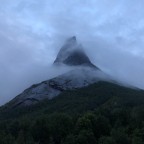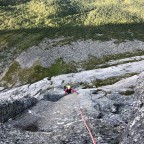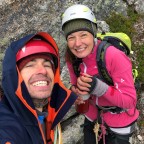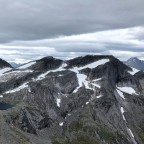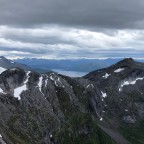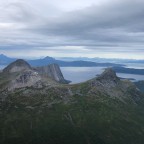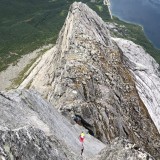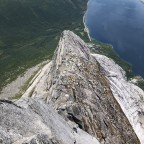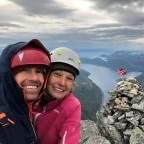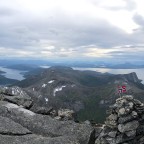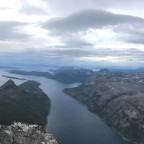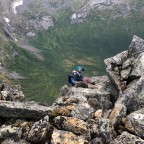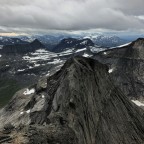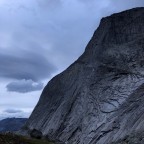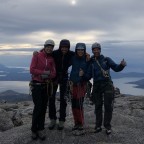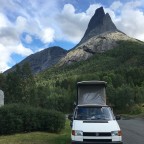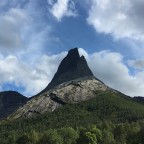Stetind
Quick decision
16.08.2019 - In a good mood we return from our climbing session to the parking area where Karen and Marius are having a snack. We wistfully check the weather forecast for the next seven days. After a rainy night the following day seems to be the only one we can still climb. The departure from the Lofoten is imminent.
Sigi: I would really have loved to climb the Storpillaren (N7, UK: E5 6a, 16 pitches, Top 50), but nobody wants to join. Do you have anything else on your list you would like to climb?
Barbara: *As far as I am concerned, we have done everything except for a climb on the Stetind. There are one or two routes which really look awesome.
Sigi: *How long? Will there be enough time tomorrow before it starts raining?
Barbara: *Climbing distance and grade vary. It depends on how fast we are.
Sigi: Which ones have you looked at?
Barbara: I have looked at the Vestveggen/Vesteggen (N6+/N6, UK: E3 5c, 8 pitches/6 pitches, Top 50) and the Sydpilaren (N6-, UK: E1 5b, 13 pitches, Top 50).
Sigi: The Vestveggen/Vesteggen seems rather promising.
Barbara: Tight schedule, but this is our last chance to go for it on this trip.
Sigi: Let us leave right away and have dinner later. Addressed to Karen and Marius: Would you like to join us?
(Note: We had this conversation in English in order to allow Karen and Marius to listen.).
Much to our delight, Karen and Marius do not think twice. The four of us set off for the Stetind. Karen and Marius drive ahead since they have already climbed the Sydpilaren on the Stetind and know how to get there fastest. On the way it starts to rain. When we arrive at the parking area near the Stetind late in the evening it is pouring. Everyone feels a bit queasy whether it will stop raining in the night and dry up properly. We decide to march off at 5 o’clock at the latest and to make the final decision at the starting point of the route. At midnight it stops raining and a strong wind sets in. The Stetind emerges from the fog.
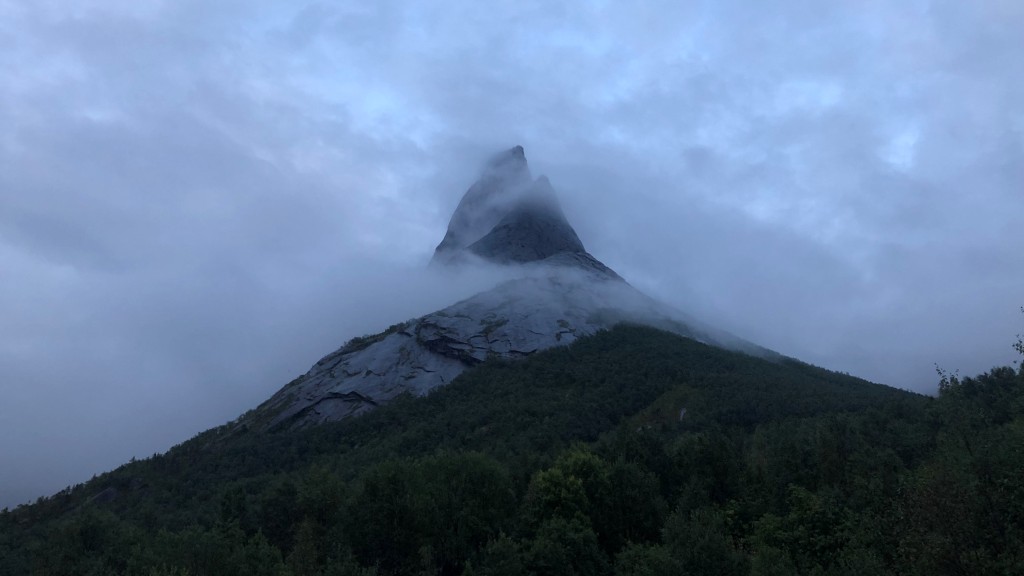
The Stetind emerges from the fog
Barbara: That was a crazy idea of mine. What have I gotten myself into?
Not knowing is comforting
Things Barbara luckily did not know at that time:
- The Stetind was appointed Norway’s national mountain in 2002.
- The Stetind is 1392 m high and known as the highest granite obelisk on earth.
- Even along the regular route its ascent involves climbing passages of grade N4+.
- Climbing the Vestveggen/Vesteggen is an ambition of many climbers in Norway, but most of them have to be satisfied with the Sydpilaren and already need about 20 hours for this climb.
Ascent of the Stetind
17.08.2019 - At 04:00 the alarm rings. Having breakfast, packing 6 cereal bars and 2 water bottles, checking the pre-packed backpacks and off we go. The approach is very quick because Karen and Marius know the directions. An icy wind is blowing at the starting point, but the rock looks dry enough for climbing. We all get ready for the ascent. Karen and I play it safe and put on long underpants as well. Sigi and I climb first because we will be doing the route finding.
Some sections of the first pitch are still wet and slippery. Therefore, we have to climb very carefully. The wind has dried up the remaining pitches of Vestveggen quite well. But it is still blowing strong and carries cold air from the snowfields to us. Since we are climbing in the shade, we are quite cold when belaying and waiting for each other. Due to his icy fingers, Sigi drops his nut set. Karen immediately gathers all nuts she has twice and hands them over to me. Just before the hardest pitch I take a picture of Sigi and I put the mobile phone back into my pocket. Unfortunately, I do not close it completely and the next strong wind gust blows it out. A stupid beginner’s mistake. I have to watch how the wind carries away the mobile phone and all of my photos taken on the Lofoten. This is what you get when you only backup every few days.
The most difficult pitch, the passage over the so-called Devil’s Dance Floor, is certainly tricky and hard at the top, but it is a great climb. However, the route description and the topo are somewhat misleading. At this point the photos of the route are most helpful. In addition, the lead climber needs to pay attention where to place the first protection. It should not be placed too low in order not to endanger the following climber.
On the ridge between Vestveggen and Vesteggen we scramble simultaneously using approach shoes and a rope. This means we are a bit slower, but some sections are still wet and the wind is quite strong and we do not want to take any risks.
The Vesteggen begins with crux, a wide and persistent crack. Sigi climbs most of the pitch without protection because he lacks the necessary gear (large camming devices). Since he has little experience with cracks and the crack is still wet, this section is mentally quite challenging for him. The crack has an unpleasant width: While Marius does a fist jam, I have to slide in my whole arm. For us the lower graded pitches are harder. Maybe because the rock is quite wet and slippery. In addition, I am now climbing with four taped fingers because the skin was worn through and they started bleeding. The N6 pitch in the upper section is particularly challenging because our topo points us in the wrong direction. Fortunately, Karen and Marius are with us. They have a description from another climbing guidebook which includes more details. Nevertheless, this pitch is mentally intense: The rock is slippery, Sigi cannot place proper protection at the crux and due to the tape I have no friction on slopers. We are happy and relieved when we reach the summit. A strong wind is blowing, but the view is amazing. After a while Karen and Marius join us and we celebrate the successful ascent.
On our descent Karen and Marius take the lead. The regular route over the ridge to the next summit, the Halls fortopp (1304 m), is quite exposed and should not be underestimated, especially when there is gusty wind. After a rappel and a few easy climbing sections, we quickly descend. Sigi and I head back to the foot of the wall to search for our nut set and my mobile phone. We quickly find the nut set, but even after an endless search we can only recover parts of the mobile phone such as the battery and the display.
After 20 hours on our feet, we finally reach Elmo shortly after midnight. Karen and Marius arrived at the parking area about 2 hours earlier, but in return we got our nuts back.
Realizing
18.08.2019 - Karen and Marius welcome us with a smile on their faces. We are all still tired, but the joy of the Vestveggen/Vesteggen outweighs. They had already given up hope of doing the route this season. The spontaneous decision to partner up for the climb was advantageous for all of us. Otherwise, we would have needed much longer and the rain break could have been too short. Furthermore, it is good to know that a second rope team can help in case of an emergency.
It takes the rest of the day for me to realize the madness of the almost 1,000 meter climb which we completed in a great time.
Overnight stay: N 68.168097, E 14.224332
Lessons learned
- Despite training such a route demands a great deal, especially the joints are hurting due to carrying the heavy backpacks.
- We like to climb light and managed to get by with four cereal bars and two bottles of water, but the next time we will bring along warmer clothes.
- The headlamp must be checked before leaving. Apparently, mine was not in lock mode and discharged in the backpack during the night. Therefore, we had to share a single one on our way back in complete darkness. This was not safe.
- There is no fool like an old fool. Sometimes you experience things you warn others about.





